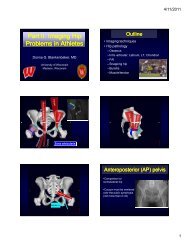Ankle and Foot 47 - Department of Radiology - University of ...
Ankle and Foot 47 - Department of Radiology - University of ...
Ankle and Foot 47 - Department of Radiology - University of ...
Create successful ePaper yourself
Turn your PDF publications into a flip-book with our unique Google optimized e-Paper software.
C<br />
D<br />
<strong>47</strong> <strong>Ankle</strong> <strong>and</strong> <strong>Foot</strong> 2287 <strong>47</strong><br />
Figure <strong>47</strong>-92, cont’d C, Shortaxis<br />
(coronal) CT scan confirms the<br />
erosion <strong>of</strong> the left lateral sesamoid<br />
(ellipse) as well as an erosion in<br />
the adjacent metatarsal head<br />
(arrow). D, Axial CT scan proximal<br />
to B reveals the marginal erosion<br />
seen radiographically in the left<br />
medial first metatarsal head (white<br />
arrow) <strong>and</strong> an erosion in the right<br />
second cuneiform (black arrow).<br />
Both erosions have well-defined,<br />
slightly sclerotic margins with<br />
sharp overhanging edges,<br />
characteristic <strong>of</strong> gout. Aspiration<br />
<strong>of</strong> the patient’s left great toe<br />
metatarsophalangeal joint yielded<br />
uric acid crystals.<br />
the source images consist <strong>of</strong> thin, overlapping slices<br />
(Fig. <strong>47</strong>-93).<br />
• Tarsal Coalitions 17,32<br />
The term coalition comes from the verb “coalesce,” which<br />
means “to grow together <strong>and</strong> form a union.” These abnormal<br />
unions are either osseous, in which there is a solid cortical<br />
bridge between the bones, or nonosseous, in which there<br />
is a fibrous or cartilaginous union between the bones.<br />
Although abnormal bone coalitions have been reported<br />
throughout the body, certain locations predominate. In the<br />
wrist, for example, carpal coalitions usually occur between<br />
the lunate <strong>and</strong> triquetrum. In the hindfoot, tarsal coalitions<br />
most commonly occur across the middle facet <strong>of</strong> the<br />
subtalar joint, <strong>and</strong> between the APC <strong>and</strong> the lateral pole<br />
<strong>of</strong> the navicular. 46 An example <strong>of</strong> the latter was already seen<br />
as an incidental finding in Figure <strong>47</strong>-81B.<br />
The subtalar joint complex consists <strong>of</strong> the subtalar<br />
joint itself <strong>and</strong> the talonavicular <strong>and</strong> calcaneocuboid joints.<br />
These joints function in unison during the gait cycle, <strong>and</strong><br />
limitation <strong>of</strong> motion <strong>of</strong> any one <strong>of</strong> these joints limits the<br />
motion <strong>of</strong> the other joints. 37 The clinical syndrome <strong>of</strong> tarsal<br />
coalition consists <strong>of</strong> pain <strong>and</strong> reduced or absent subtalar<br />
motion, as well as pes planus (flat-foot) <strong>and</strong> peroneal<br />
muscle spasm (clonus on inversion stress). 4,43 The exact<br />
cause <strong>of</strong> the peroneal spasm is uncertain; however, peroneal<br />
muscle tightness is the result <strong>of</strong> tarsal coalition, not<br />
the cause. Symptoms usually manifest between 12 <strong>and</strong> 16<br />
years <strong>of</strong> age <strong>and</strong> worsen with increasing age. Conservative<br />
treatment options include anti-inflammatory medication<br />
<strong>and</strong> a trial <strong>of</strong> reduced activity, cast immobilization, <strong>and</strong><br />
molded orthoses. If conservative treatment fails, surgical<br />
options include resection <strong>of</strong> the coalition <strong>and</strong> arthrodesis<br />
if secondary osteoarthritis has developed.<br />
According to the literature, tarsal coalitions are bilateral<br />
in 50% to 60% <strong>of</strong> cases. However, in searching our<br />
database for examples for this chapter, we found that bilaterality<br />
was the rule. Perhaps because our CT protocol<br />
entails scanning both feet, we are apt to find asymptomatic<br />
coalitions <strong>and</strong> other incidental variants, such as the os<br />
calcaneus secondarius (a forme fruste <strong>of</strong> calcaneonavicular<br />
coalition), in the contralateral foot (Fig. <strong>47</strong>-94).<br />
A talar beak is an indirect sign <strong>of</strong> a tarsal coalition. Seen<br />
best radiographically on the lateral view (Fig. <strong>47</strong>-95A) or<br />
on a sagittal CT (Fig. <strong>47</strong>-95C), the talar beak is not part <strong>of</strong><br />
the coalition but a result <strong>of</strong> it. The altered biomechanics<br />
across the talonavicular joint can result in a traction spur<br />
(enthesophyte) arising from the dorsal head <strong>of</strong> the talus.<br />
Text continued on p. 2293<br />
Ch0<strong>47</strong>-A05375.indd 2287<br />
9/9/2008 5:35:40 PM
















